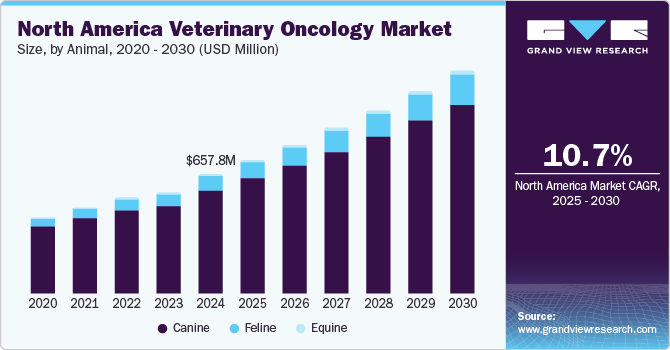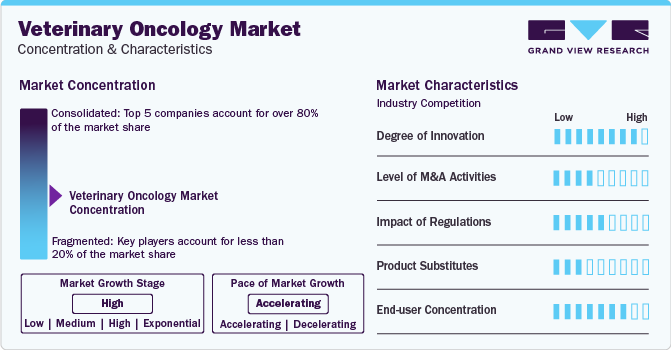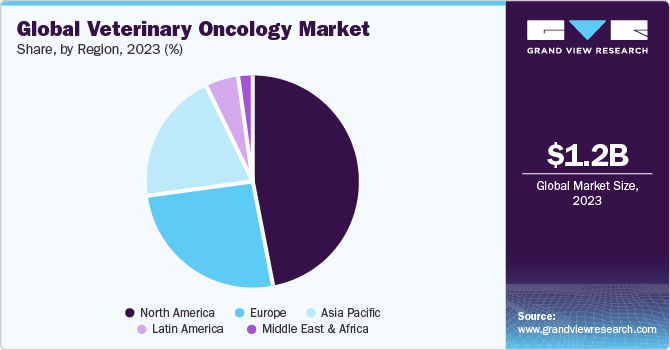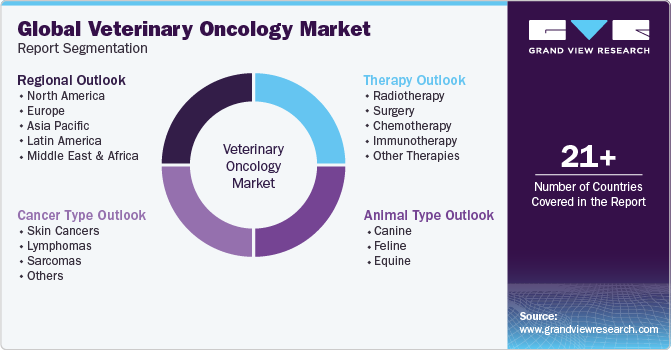- Home
- »
- Animal Health
- »
-
Veterinary Oncology Market Size And Share Report, 2030GVR Report cover
![Veterinary Oncology Market Size, Share & Trends Report]()
Veterinary Oncology Market Size, Share & Trends Analysis Report By Therapy (Radiotherapy, Surgery), By Animal Type (Canine, Feline), By Cancer Type, By Region, And Segment Forecasts, 2024 - 2030
- Report ID: GVR-4-68038-182-5
- Number of Report Pages: 130
- Format: PDF, Horizon Databook
- Historical Range: 2018 - 2022
- Forecast Period: 2024 - 2030
- Industry: Healthcare
Veterinary Oncology Market Size & Trends
The global veterinary oncology market size was estimated at USD 1.18 billion in 2023 and is anticipated to grow at a compound annual growth rate (CAGR) of 11.29% from 2024 to 2030. Rising prevalence of cancer in the pet population, coupled with growing adoption of veterinary cancer therapy as a treatment method, is primarily propelling market growth. Growing R&D in veterinary oncology to provide optimal pet cancer treatments and pet insurance is expected to propel market growth. In addition, In July 2023, Ardent Animal Health partnered with FidoCure to expand access to oncology innovation in veterinary medicine by leveraging the latter's genomic testing and precision medicine platform.

According to the National Center for Biotechnology Information, in 2022, cancer was the leading cause of death in cats and dogs. Hence, diagnosis and treatment of cancer are critical to treat & improve the survival rates of pets effectively. Moreover, study states that in the U.S., out of around 76.8 million domesticated dogs and 58.4 million cats, around 4 million dogs & 4 million cats are diagnosed with cancer every year. Therefore, with a rising number of these cancer incidents, there is a necessity for effective veterinary oncology treatment.
A majority of pet owners got closer to their pets during the COVID-19 lockdowns aimed at curbing disease transmission. As life returns to normal, pet owners have integrated their pets into their daily practices, prioritizing pet-friendly vacations and workplaces. 75% of pet owners surveyed by APPA stated that spending time with their animals helped decrease stress and improve well-being during and post-pandemic. At animal shelters, adoption rates soared as much as 40% in 2020 over earlier years in the U.S.
The increasing number of veterinary clinical studies evaluating the safety and efficacy of different oncologic treatments in pets further boosts market growth. AVMA created an AVMA Animal Health Studies Database (AAHSD) tool for prospective veterinary clinical study investigators. Such studies by researchers focused on veterinary oncology treatment are anticipated to fuel market growth over the forecast period.
Growing expenditure on animal healthcare in developed economies due to rising willingness to spend on pet healthcare by owners and initiatives by government for veterinary cancer treatment are major factors fueling market growth. In May 2021, the World Small Animal Veterinary Association established (WSAVA) Oncology Working Group (WOW) to develop global guidelines for veterinary oncology practice. This would help educate owners about cancer in pets and help veterinarians improve treatment standards. Thus, growing research investments and initiatives by industry stakeholders in veterinary oncology will likely help attain significant growth in the coming years.
Market Concentration & Characteristics
The global veterinary oncology market is characterized by a high degree of innovation, with new technologies and methods being developed and introduced regularly. Medical technologies, treatment modalities, and research advances have contributed to developing more effective and targeted animal cancer therapies.
Several market players such as Elanco, Dechra, Siemens Healthineersare, and Karyopharm involved in merger and acquisition activities. Through M&A activity, these companies can expand their geographic reach and enter new territories.

Regulations play a significant role in shaping the veterinary oncology industry. These regulations are in place to ensure the safety and efficacy of treatments and promote ethical practices in developing and administering veterinary oncology products.
Moreover, spiraling collaborations for R&D of targeted therapies for cancer in companion animals is another contributing factor for market growth. For instance, in June 2022, Boehringer Ingelheim entered into a research partnership with a biopharma company- CarthroniX, to develop small molecule therapeutics in canine oncology. Such activities represent a promising yet challenging perspective and are expected to bring a new paradigm to pet cancer therapy.
Regional Insights
North America dominated with a share of more than 45% in 2023. The segment is projected to dominate the market over the forecast period. Key growth contributors are increasing focus on pet health, presence of many pet drug manufacturing companies, and speedy adoption of innovative pet care medications. In addition, the increasing number of government funding for pet oncology treatment in this region, pet insurance adoption, and the presence of market giants in the oncology market are also driving the market.

Moreover, according to the National Cancer Institute, in 2022, 32 million cats and 65 million dogs live in the U.S. According to preliminary estimates of cancer incidence, roughly 6 million dogs are diagnosed with cancer annually, and a comparable number is reported in cats. Similarly, according to the American Veterinary Medical Association, in 2022, one in four dogs was estimated to develop cancer at some stage. Noticeably, lymphoma was recorded to be higher in cats than in dogs. Therefore, increasing cancer incidence in pet animals is expected to fuel market growth in North America.
Asia Pacific market is expected to grow over the forecast period owing to increasing awareness about various pet treatment methods among veterinarians, improving veterinary healthcare infrastructure, and rising animal healthcare expenditure.
Therapy Insights
Based on therapy, the surgery segment dominated the market with a revenue share of over 36% in 2023. Surgery is often most effective for tumors that can be completely removed without threatening crucial structures that have not yet spread to other parts of the body. In the case of cancer, it is often the first step. If the tumor is low-grade and there are no signs of local or distant metastasis, cancer surgery could help in achieving remission. Successful surgery negates the need for additional therapy. Growing instances of surgeries performed on pets for their treatment and technological advancements in these procedures contribute to the market growth. In addition, a growing number of research projects, including surgeries on pet populations, are being conducted, which is further boosting the market's expansion.
The immunotherapy segment is anticipated to witness the fastest CAGR over the forecast period. Immunotherapy is most promising recent developments in tumor treatment, strengthening the body's immune response against cancer. Several nonprofit organizations dedicated to animal health research are sponsoring studies to bring new treatment options to the market. For instance, the University of Minnesota received funding from the Morris Animal Foundation in January 2023 to study & develop novel immunotherapeutics for big-breed dogs suffering from osteosarcoma. Osteosarcoma is a fatal bone cancer. Thus, companies working on immunotherapeutic R&D for veterinary cancer also contribute to the market's expansion. Moreover, the market is growing due to several veterinarians dedicated to conducting immunotherapy clinical trials and growing investment in canine oncology clinical trials. For instance, in November 2022, NCI funded clinical trials for canine immunotherapy. Similarly, the NIH funded a dog immunotherapy data center to support the development of treatments.
Animal type Insights
The canine segment dominated the market with a revenue share of over 86% in 2023. The rising pet dog population, prevalence of cancer, and awareness of treatment options contributed to the significant share of the canine segment in 2023. Rising incidence of canine cancer, investment in veterinary oncology research & development, and growing veterinary healthcare costs are expected to drive market growth. The demand for efficient and cutting-edge therapies for cancer is expected to grow along with the prevalence of canine cancer cases, fueling segment growth. For instance, as per the study published in February 2022 by Aging and Cancer, it is predicted that one out of every four dogs will be diagnosed with tumors in their lifetime. Cancer is the main cause of mortality for dogs older than middle age. Therefore, the need for treatments will continue to increase due to the growing incidence of cancer in dogs, driving sector growth.
The feline segment is anticipated to grow at a lucrative rate in coming years. According to the American Veterinary Medical Association (AVMA), the pet cat population in 2022 was 58.3 million in the U.S., which is expected to increase over the coming years. Between 2016 and 2020, cat ownership increased (from 25% to 26%), and then again in 2022 (to 29%). In addition, according to the Canadian Animal Health Institute (CAHI), 58% of Canadian households owned at least one cat or dog in 2022. Cats’ population increased from 8.1 million in 2020 to 8.5 million in 2022. CAHI also revealed that percentage of pets receiving medical care increased significantly in 2022. In addition, cat-related visits to vets increased dramatically in the months following the COVID-19 outbreak. According to the World Small Animal Veterinary Association (WSAVA), one in five cats is susceptible to acquiring cancer throughout its lifespan. According to estimates, market growth is driven by increasing numbers of pet cats, higher cancer rates, and more frequent veterinary visits.
Cancer type Insights
Based on cancer, the skin cancers segment dominated the market with a revenue share of 39.1% in 2023. This segment includes mast cell tumors, squamous cell carcinoma, and melanoma. Squamous cell carcinoma affects both cats & dogs, and skin tumors are the most typical form of mast cell cancer in older dogs. In 2018, 21% of all canine skin tumors were mast cell tumors, according to Veterinary Information Network, Inc. Mast cell tumors fall into lower grades from I to III. This malignant tumor affects the squamous epithelium of the skin, oral cavity, and digits. In cats, around 25% of all genital tumors are squamous cell carcinomas of the toe(s), and surgery is the most advised treatment. In addition, mammary tumors are very common in cats, especially between the ages of 10 and 14. Breeds with a particular propensity for the tumor, such as Siamese cats, are more likely to experience it at an early age.
The other segment is estimated to grow at the fastest CAGR of 11.99% from 2023 to 2030. Growing incidence of adenocarcinoma is expected to drive segment growth during the forecast period. According to data published by Veterinary Practice in September 2022, dogs with anal sac adenocarcinomas account for 17% of all perianal cancers. As they are slowly growing tumors, the prognosis is typically favorable.
The proven oncology treatment for lymphoma is chemotherapy, which also varies depending on the type of cancer. According to the American Kennel Club, dogs' most common types of lymphoma are mediastinal lymphoma, multicentric lymphoma, alimentary lymphoma, and extranodal lymphoma, which vary in survival rates, aggressiveness, and clinical signs. The organization also states that 80 to 85 % of lymphomas in dogs were found to be multicentric. Lymphoma is followed by mast cell cancer, along with mammary and squamous cell cancer. Increasing mast cell cancer in dogs is expected to drive the market.
Key Companies & Market Share Insights
The market for veterinary oncology is witnessing immense competition as various large pharma and medical device companies offer oncology products for veterinary use. Market players focus on implementing new strategies such as regional expansion, mergers, acquisitions, new product introduction, partnerships, and distribution agreements to increase their revenue share and mark their presence. Elanco acquired Tanovea from VetDC, Inc. in July 2022, after which the company declared the formation of a commercial team devoted to the veterinary specialty business.
Another contribution by the market player in August of the same year was initiating a Phase 2 clinical trial by PharmAust in Australia with its leading veterinary drug candidate, monepantel, to treat canine cancer. PharmAust patented and reformulated monepantel as a repurposed anti-cancer drug for veterinary cancer and plans to have an agreement with Elanco for this veterinary cancer application. Therefore, reformulating these drugs for veterinary oncology treatment will help to accelerate company’s development and fuel market growth.
Recent Developments
-
In September 2023, FidoCure, published research finding highlighting various precision medicine tools for veterinarians for understanding hemangiosarcoma (HSA), a common aggressive canine cancer. Diagnosis of HSA is very devastating for dog owners as diagnosis process is very painful and lengthy. Hence, genomic sequencing of hemangiosarcoma can provide data to help veterinarians better understand prognosis of HSA patients and allow pet parents to make informed decisions regarding life and death decisions for their pets.
-
In July 2023, Ardent Animal Health partnered with FidoCure to expand access to oncology innovation in veterinary medicine by leveraging latter's genomic testing and precision medicine platform.
-
In April 2023, Torigen Pharmaceuticalspartnered with Veterinary Management Groups (VMG) to provide their experimental autologous prescription products and services to over 2,000 member clinics network.
-
In August 2022, ELIAS Animal Health demonstrated cancer-killing capabilities through activated T cell immunotherapy, ELIAS Cancer Immunotherapy (ECI). Mechanism of action for ECI has been demonstrated in an in vitro study by using cancer and T cells collected from dogs treated with ECI for osteosarcoma.
Key Veterinary Oncology Companies:
- PetCure Oncology
- Zoetis
- Karyopharm Therapeutics, Inc.
- Varian Medical Systems
- Accuray Incorporated
- Boehringer Ingelheim GmbH
- Elanco
- One Health
- Regeneus Ltd.
Veterinary Oncology Market Report Scope
Report Attribute
Details
Market size value in 2024
USD 1.33 billion
Revenue Forecast in 2030
USD 2.52 billion
Growth rate
CAGR of 11.29% from 2024 to 2030
Base year for estimation
2023
Historical data
2018 - 2022
Forecast period
2024 - 2030
Report Updated
November 2023
Quantitative units
Revenue in USD million/billion and CAGR from 2024 to 2030
Report Coverage
Revenue forecast, company share, competitive landscape, growth factors, and trends
Segments covered
Therapy, animal type, cancer type, region
Regional Scope
North America; Europe; Asia Pacific; Latin America; MEA
Country Scope
U.S.; Canada; Germany; UK; France; Italy; Spain; Japan; China; India; Brazil; Mexico; South Africa
Key companies profiled
PetCure Oncology; Zoetis Inc.; Karyopharm Therapeutics, Inc.; Varian Medical Systems; Accuray Incorporated; Boehringer Ingelheim GmbH; Elanco; One Health; Regeneus Ltd.
Customization scope
Free report customization (equivalent to up to 8 analysts’ working days) with purchase. Addition or alteration to country, regional, and segment scope.
Pricing and purchase options
Avail customized purchase options to meet your exact research needs. Explore purchase options
Global Veterinary Oncology Market Segmentation
This report forecasts revenue growth at global, regional, and country levels and analyzes the latest industry trends in each of the sub-segment from 2018 to 2030. For this study, Grand View Research has segmented the global veterinary oncology market report based on therapy, animal type, cancer type, and region:

-
Animal type Outlook (Revenue, USD Million, 2018 - 2030)
-
Canine
-
Feline
-
Equine
-
-
Therapy Outlook (Revenue, USD Million, 2018 - 2030)
-
Radiotherapy
-
Surgery
-
Chemotherapy
-
Immunotherapy
-
Other Therapies
-
-
Cancer Type Outlook (Revenue, USD Million, 2018 - 2030)
-
Skin Cancers
-
Lymphomas
-
Sarcomas
-
Others
-
-
Regional Outlook (Revenue, USD Million, 2018 - 2030)
-
North America
-
U.S.
-
Canada
-
-
Europe
-
UK
-
Germany
-
France
-
Italy
-
Spain
-
-
Asia Pacific
-
Japan
-
China
-
India
-
-
Latin America
-
Brazil
-
Mexico
-
-
Middle East & Africa
-
South Africa
-
-
Frequently Asked Questions About This Report
b. The global veterinary oncology market size was estimated at USD 1.18 billion in 2023 and is expected to reach USD 1.33 billion in 2024.
b. The global veterinary oncology market is expected to grow at a compound annual growth rate of 11.29% from 2024 to 2030 to reach USD 2.52 billion by 2030.
b. North America dominated the veterinary oncology market with a share of over 45% in 2023. This is attributable to the high prevalence of cancer in pet animals, rising pet companionship, high spending on animal healthcare in the region.
b. Some key players operating in the veterinary oncology market include Boehringer Ingelheim International GmbH, Elanco, Zoetis, PetCure Oncology, Accuray Incorporated, Varian Medical Systems, Inc., Nippon Zenyaku Kogyo Co., Ltd; Morphogenesis; Karyopharm; Regeneus Ltd; and OHC
b. Key factors that are driving the veterinary oncology market growth include the growing prevalence of cancer in companion animals, increasing R&D in veterinary oncology, a growing number of pet ownership, technological advancements in pet cancer treatment.
Share this report with your colleague or friend.
![gvr icn]()
NEED A CUSTOM REPORT?
We can customize every report - free of charge - including purchasing stand-alone sections or country-level reports, as well as offer affordable discounts for start-ups & universities. Contact us now
![Certified Icon]()
We are GDPR and CCPA compliant! Your transaction & personal information is safe and secure. For more details, please read our privacy policy.
We are committed towards customer satisfaction, and quality service.
"The quality of research they have done for us has been excellent."





